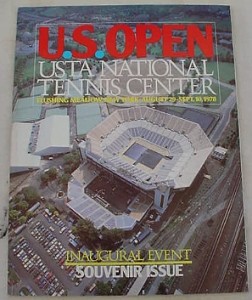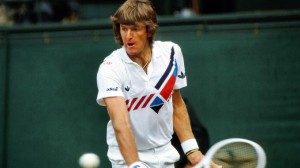by Randy Walker
@TennisPublisher
In was on August 29, 1978 when American tennis was turned on its head. Gone was the national championship of the United States being staged at a staid private club at the West Side Tennis Club at Forest Hills as the U.S. Open debuted at the new USTA National Tennis Center in Flushing Meadows. The era of the big and loud U.S. Open began.
The anniversary is documented in the my book “On This Day In Tennis History” here:
The gates open at the new USTA National Tennis Center in Flushing Meadows, N.Y. for the grand opening of the newly-constructed public facility that is the new home of the U.S. Open. “Tonight the US Open belongs to us, the people, the tennis fans,” says actor and comedian Alan King, the master of ceremonies for the opening session of the tournament. “Ten months ago when we broke ground I thought they were crazy. But here we are. This is where the legends begin.” Bjorn Borg and Bob Hewitt play the first match at the new facility with Borg winning the best-of-three set first round match 6-0, 6-2. “Probably when I get to be 75 years old and look back, I’ll say I was the first one to play in the new stadium,” says Borg after defeating Hewitt in front of only 6,186 fans during the opening night session of the tournament.
In his life-long book on tennis “The Bud Collins History Of Tennis” Bud Collins presented the massive change in American tennis culture and growth in the following way.
Perhaps nothing better symbolized what happened to the once-elitist, white-flanneled sport of tennis in the 1970s than the fact that the U.S. Open, America’s premier tournament, moved to a public park, in Flushing Meadow, Queens, N.Y. The USTA National Tennis Center was built, remarkably, in one year on 16 acres of city-owned land in Flushing Meadow-Corona Park, adjacent to Shea Stadium.
Relocated to Flushing by drawling, cigar-chomping USTA President W. E. “Slew” Hester, a 66-year-old wildcat oilman from Jackson, Miss., the U.S. Championships was retreating from 97 years in such patrician clubs as Newport (R.I.) Casino, Philadelphia Cricket Club and the West Side Tennis Club. Hester talked like a Southern conservative, but proved in a memorable two-year term to be perhaps the most progressive president in the history of the USTA. Many second-guessed him in September 1977 when, fed up with the reactionary board of governors of the West Side Tennis Club, he announced that the Open would be moved. Few believed the new complex Hester envisioned a couple of miles away could be completed in 12 months, and many considered the project “Hester’s Folly.” But Hester’s perseverance and leadership, despite arthritis so severe it was difficult for him to walk, enabled the USTA to cut through bureaucratic red tape, union disputes and cost overruns and get the splendid complex built in time for the 1978 Open.
The USTA National Tennis Center was dedicated on Aug. 30, 1978. Its main arena—Louis Armstrong Stadium, site of the Singer Bowl for the 1964-65 World’s Fair and named for the late jazz great who lived nearby—accommodated nearly 20,000 spectators, with barely a bad seat in the house. In addition to the steeply banked, red, white and blue stadium, the complex included a 6,000-seat grandstand, 25 additional lighted outdoor courts, and 9 indoor courts, all with the same acrylic asphalt surface that approximates the hard courts most Americans play on. Under a lease agreement between the USTA and the city of New York, the facility is open to the public year-round and is available to the USTA for tournaments and special events 60 days a year, at a modest fee. The USTA, in turn, spent $10 million to renovate and enlarge a stadium that was intended for concerts but had fallen into terrible disrepair.
The result was the most significant new venue for world tennis since the modern All England Club was opened in the London suburb of Wimbledon in 1922 and Stade Roland Garros was dedicated as a civic monument in Paris for the 1928 Davis Cup Challenge Round.


